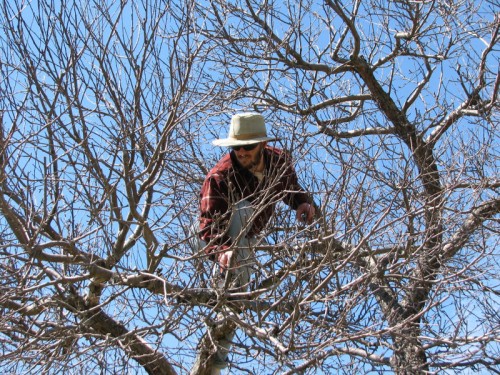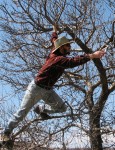Since I’m no longer living at home, I don’t have seven days out of every week in which I can choose when and how long to prune. I’m only home on Sundays, and Sunday afternoon is really the only time I have of that day free to prune. That means instead of having thirty days in a month when I can choose to prune, I have four or five. And that is assuming every Sunday afternoon is actually free and the weather is of acceptable quality.
Pacing the pruning work
I could, of course, have not pruned the apple trees at all. The world would not have ground to a halt, the universe would not have come crashing down. Or, I could have tried to get someone else to do the pruning. But, while pruning is sometimes uncomfortable work, I enjoy it. I enjoy molding the trees to my vision, and shaping them as I see best. So I didn’t want to give up my spring ritual, and besides, nobody else in the household has been trained, and Dad is now too old. The options were either leave the trees unpruned, let someone else attempt to butcher them, or do it myself.
I chose the last option.
I realized early on that I couldn’t take my normal lax approach. There would be no last minute rush to get the trees pruned before they bloomed (a painfully far too late approach). No, I would have to get started early—very early.
I figured three afternoons per tree, which made for a total of nine weekends. Further, I conceded that such an estimate was optimistic, presuming weather each weekend was acceptable and I had free time every weekend. So perhaps a more reasonable estimate would be a total of twelve weeks.
Three months.
Oh, dear. That meant I had to start as early as possible. As in, the first weekend where I wouldn’t freeze to death if I climbed up into a tree and sat there for several hours. And so February found me trudging out in the snow to begin my labor.
Pruning in late winter
While straining from the uppermost branch of a tree to reach the farthest out twig for pruning, stressing joints and limbs and putting oneself on the verge of falling out of the tree is never fun, on the whole sitting up on an apple tree on a sunny and fresh spring day is a wonderful activity in my book. Sitting bundled up in an apple tree in the middle of February slowly freezing solid while you strain to reach that furthest out twig comes in much further down in my book of fun activities. It may be sunny, but numbing hands and freezing knees detracts from the enjoyment, and in the back of your mind you’re thinking, “I wonder when I can go inside. Work faster, faster, and maybe we’ll get done sooner. Boy, I’m getting cold. I wonder when I can go inside . . .”
I keep saying I’ll do a little bit more, I need to get more done. I’ll do just a few more branches . . . and then I finally go inside and realize that I’m a little more chilled to the bone than I realized.
Can’t use a ladder with snow on the ground
There are other difficulties, too. The ground under our apple trees isn’t level or even, so working from a ladder is somewhat hazardous to begin with. Now I simply cannot do some of the pruning until the snow cover leaves the ground. I have had to limit myself to perching in the higher branches and doing that pruning which cares not how much snow is on the ground . . . and content myself with the thought that if I do fall out of the tree there are six inches of snow to cushion my fall.
It is now the middle of March and I’m probably between a third and halfway done. It hasn’t gone as fast as I had hoped, but is probably on track for the three month completion date. Right now I work with snow on the ground, but at my speed I’ll be racing to complete the finishing touches before the trees break out in bloom. It’s a little hard to believe when you’re sitting up in the tree out in the cold—you’re tempted to think that you can put this off to the next weekend when it won’t be so miserable . . . but then you do the math and realize that far from being able to take a break you must work faster.
Pruning for apple production
However, the unpleasant chill fails to dim my satisfaction in the work. I am still learning how to prune better, still bringing my trees a little closer to that apple tree ideal. Some time before last year’s pruning the whole idea of not having a tree competing against itself finally clicked in a way it hadn’t before. Before I was always making sure that limbs didn’t cross, didn’t rub, and were growing in the proper direction (none straight up or straight down, for example). All of that was well and good, but it failed to take into account how the different branches and different limbs related to each other. A limb which is shaded out by another limb will be inefficient, unproductive, and inclined to grow in a poor manner. If one branch is completely shading another branch, one of them must go. If one branch is mostly shading another branch, it must go.
In a way I was pruning the apple trees like any other tree—making sure there was no physical weakness or deformity. But an apple tree has a very particular shape—or, I should say, it should if properly shaped by the orchardist—and this shape is very much an expression of the needs of the apples which the tree will produce. In simply making sure no branches were crossing or growing in a weak manner, I was still letting too many branches flourish. Working under this generous standard I was cultivating thick bunches of branches. Perhaps they didn’t rub against each other, or cross, or grow out at odd angles, but these compacted bunches of branches were shading each other out. I had twice as many limbs working half as efficiently as they should.

Rundy thinning out a twiggy mass in 2006. Rundy's pruning methods are not considered safe. Don't follow his example. - Photo by Cadence Purdy
Yes, I’m a slow learner. Last year it finally clicked—instead of each limb forming a bunch of branches in something like a closed fist each limb need to spread out like a spreading hand. And each limb needed to spread out in its own space, catching its own bit of sunlight as best it could. Where one limb interfered with the sunlight of another limb, that interference had to be done away with as much as possible.
I came to that realization last year and began implementation. It required serious branch thinning, and while I didn’t go as far as needed last year I saw a big improvement by what I did. This year I am following up and I expect by the time I finish pruning this spring my trees will pretty much find themselves hewed to the proper line. There is a satisfaction to setting trees right and proper that perhaps only someone who works with trees can fully appreciate.
Originally posted at Letters to a Silverware Thief.





Loved the pictures — may not be safe (certainly not my method) but definitely my son’s method of pruning (it’s why I have grey hair!) Your comments are so in tune with nature — my son also loves to meditate in treetops…. thanks for the info and the pics.
Dangerous or not, I like the pictures! I think gardeners are clever enough to make up their own minds as to methodology when taking on gardening tasks…so to each his own!
I stand by my statement that one’s feet do not leave the ground. There are long-handled clippers (as well as saws) that are able to handle any job at the top of a large apple tree.
Contrary to your statement that “Pruning large apple trees is dangerous and there’s no getting around that fact” – – let me clearly state that pruning apple trees need not be dangerous – and that’s the point to these notes. Long handled “pole pruners” or “pruning sticks” (they come in different lengths) have been around for over a hundred years. Fiskars (I have no affiliation with this company) produces an excellent range of these tools and your readers can find them by googling “fiskars pole pruners” for price comparisons.
The small costs of these tools are irrelevant when compared to the costs of spending one’s life in a wheelchair (as did a relative after falling a mere 6′ from an apple tree while spring pruning).
I hope this helps.
Doug
Doug,
I would never defend my activities as being a demonstration of the best or safest method for pruning. I would agree with you whole heartedly that I take an exceptionally dangerous approach to pruning.
That is my choice, and a reflection of my personality. I’m not writing here as an authority on gardening, but rather as a hobbyist gardener relating his adventures with all of his personal quirks and foibles. In my writing I have presumed that my readership is mature enough to judge for themselves whether my actions are wise or not.
But, in case it wasn’t clear to anyone, I will state it clearly now: Climbing in trees in the manner demonstrated is extremely dangerous!
However, having agreed that I am not a model of safe gardening practices, I disagree strongly with your statement that “One does not leave one’s feet.”
Perhaps one can say that about the minor corrective pruning required for on-fruit-bearing trees, but unless you have a “cherry picking” truck with the attendant bucket to ride in, it is absolutely required that one do a lot of climbing to prune a mature full sized apple tree. It is impossible to do all of the fine pruning of the fruit bearing branches of an apple tree from the ground, using a long arm saw. One is not pruning only large branches, but also making a selection among much smaller wood stock–in effect, deciding which twigs will be saved for fruiting and which will be discarded. For that fine selection one needs to get close to the work, whether it be by ladder, by bucket truck, or
by climbing.
Leaving one’s feet is dangerous, whether it be climbing in a tree or on a ladder. Pruning large apple trees is dangerous, there is no getting around that fact. A small time orchardist must decide if they are willing to take that risk or not.
Unfortunately, I have never seen such a dangerous display of poor pruning practices as the pics in this post unless I was attending a safety seminar and saw the “before-the-accident” pictures.
Climbing around on a tree to prune is an invitation to disaster and should be avoided at all costs. One does not leave one’s feet. One does not reach across tree limbs like this.
One does purchase proper pruning equipment for tall trees (only a small investment compared to the alternatives) from a company such as Fiskars.
While I’m normally a fan of your blog, in this case I’m disappointed with this very poor gardening practice that could get somebody hurt.
Doug
Please note that the photo with the article is from last year.